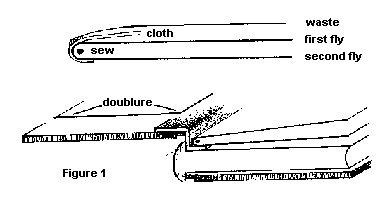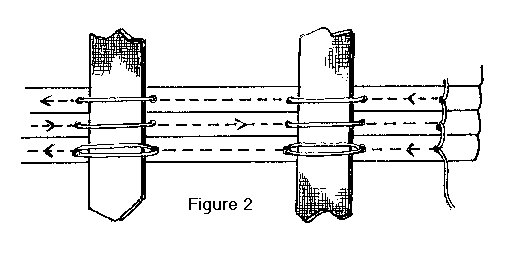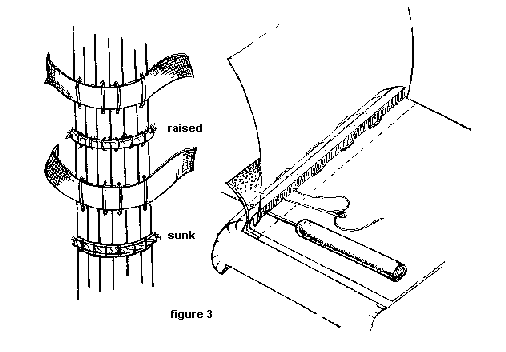
Volume 8 - Autumn 1999
Good Books, Sound Binding - Part 1
by Arthur W. Johnson
When a book is to be repaired or rebound, there are two considerations. Primarily the text should be preserved for posterity by sound construction and durable materials. On the other hand the binding may be renovated in order to make it a saleable item. Old books are attractive and prized when covered in smooth calf leather and embellished with gold and blind ornamentation. These features can be retained when the binding is restored by a skilled craftsperson. However many antiquarian books have a weak construction because of competitive trade practices in the past. The common faults are unsatisfactory sewing, over pared leather and covers decorated by harmful methods. Recreating these in order to make the binding appear authentic does not improve the book's strength, nor is it sound craftsmanship. It is the custom to rebind or repair in order to simulate the style prevalent at the period the book was published. This is acceptable but it can be an error if the book is not bound to suit its purpose. Many books of faulty construction find their way into libraries where careless handling by readers and inexperienced staff may cause rapid breakdown.
The chief custodian of a technical library selected books dated between 1550 and 1840 to be rebound with a modem construction based on scientific principles. They were to be available in the reference section and be able to withstand constant handling and pollution. The cost of rebinding had to be reasonable.
In consultation with a binding craftsman the work was carried out to the following specifications where all materials should be of near neutral pH value as possible.
- Siding Cloth of linen or linen-cotton mixtures
- Jaconette and archival linen for strengthening and linings
- Unbleached linen thread
- Unbleached linen tapes in various widths
- Acid free millboard
- Powdered flour paste prepared daily
- Pearl glue and flexible glue must be clean and thinly applied
- (Synthetic adhesives were not in general use at the time) 22 carat gold leaf
- Best quality cartridge, off white and coloured, for endpapers
- Marbled paper for siding small books
- Repair tissues, manilla and bonds for sundry use
- Morocco leather, PIRA tested, prepared with hydrolysable tannins and 1mm thick
- Levant morocco for large and thick volumes
 Preparation
Preparation
Books in need of resewing were taken down and the gatherings cleaned. The old grooves were knocked out and the leaves were checked for dog-ears and tears. These were strengthened and the backs of damaged sections or folds repaired with bond paper. Tipped in plates were freed and guarded round the sections. The text block was pressed for a week until solid.
The boards of soundly sewn books were eased from their cords or tapes. Spine leather with linings was removed with a knife and discarded. The scraps of linings and glue remaining on the spine were layered with watery paste. After soaking they were cleaned off thoroughly with the back of a knife without damaging the threads, tapes or cords. (This process could have been left until the book was prepared for rounding and backing where a moist spine is an advantage.)
Endpapers
An exposed cloth jointed endpaper was chosen and thin cloth was used for small volumes and a buckram for heavier volumes. Each endpaper was cut 12mm larger and the adhesive was glue. The board paper was to be a doublure. See figure 1
 Sewing
Sewing
Pressed sections were marked up for sewing in the usual way. Books previously sewn on three tapes were given four with additional tapes for heavier volumes. Ignoring the sawn in cerfs the tapes were spaced so that the distance from the bottom edge of the spine to the lowest tape was approximately 4mm greater than the spaces between each of the others. End papers were trimmed to size at head and tail and sewn in the same way as the sections except that the thread continued twice around the tape in order to have a continuous line of stitches through the endpapers. See figure 2. Endpapers for the sewn books were trimmed to size at head and tail and after jointing with a folder and ruler were glued snugly into the existing joint. No book edges were cut.
Backing
Books were glued up, knocked up, rounded and backed using common procedure. Those already backed had their joints sharpened. Wooden backing boards are preferable to those with brass or aluminium edges as they are considered to be more sympathetic to the endpaper materials.
Setting
Backs were then 'set' by placing the books in a standing press and then covering the spines with a thin layer of paste. After soaking for five minutes the glue used in the backing was cleaned off to leave fine lines of adhesive between the sections. They were left to dry.
Sewing through the joint
Linen tapes are extremely durable and are attached to the spines of cord sewn books by means of the endpapers. Holes were pierced through the right angle of the joint to emerge no lower than the first and last two sections. Saddle stitching provides a continuous row of stitches between the flyleaves going in and out around the tape and avoiding the cords. It is an advantage to mark the position of the tapes and then to sew; and by pulling the tape through the loops the stitching would be tighter. Weighty thick books were also sewn at intervals through the spine. The needle pierced the centre of each spaced section and the thread knotted at the end of the completed line. See figure 3. After the endpapers had been secured by sewing they were trimmed flush at the foredges.
Arthur W. Johnson, A.T.D., N.D.D. was born in 1920. As well as holding an Art Teacher's Diploma and a National Diploma in Design he is also an Honary Fellow of both the Institute of Craft Education and Designer Bookbinders.
Arthur has held teaching posts at Hornsey College of Art, Hammersmith School of Art, Willesden College of Art and the London College of Printing. He retired from teaching several years ago. He has also lectured extensively in England, Canada and New Zealand. His work has included Calligraphy, Fine Binding and Antiquarian Book Restoration and his bindings can be found in many public and private collections, including the British Museum.
His excellent book, the Manual of Bookbinding by Thames & Hudson is considered as one of the foremost reference works for bookbinders and is recommended as essential reading by many teachers of bookbinding. He has also written several other books.
